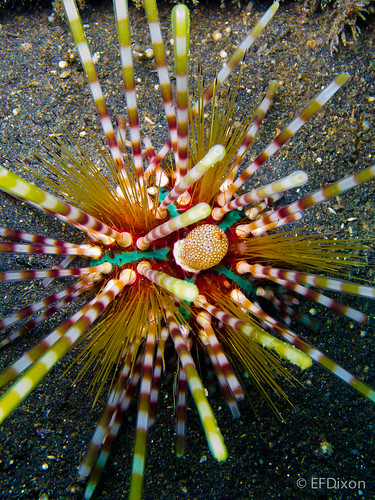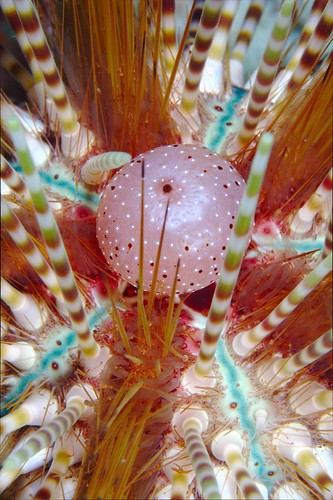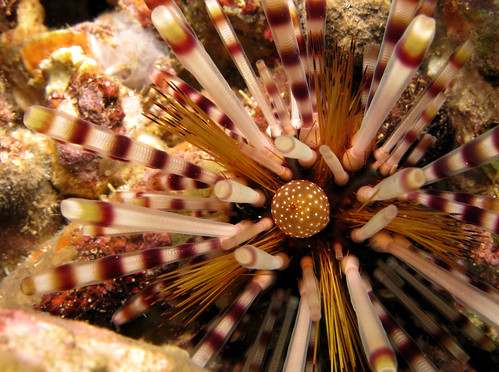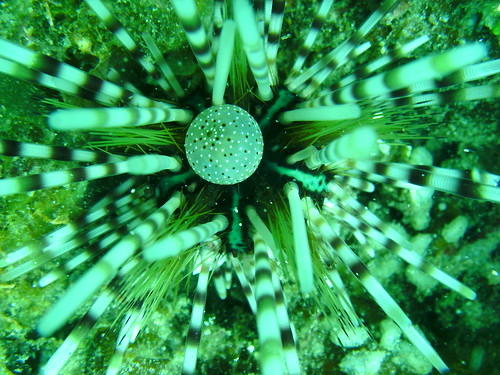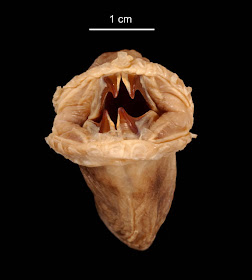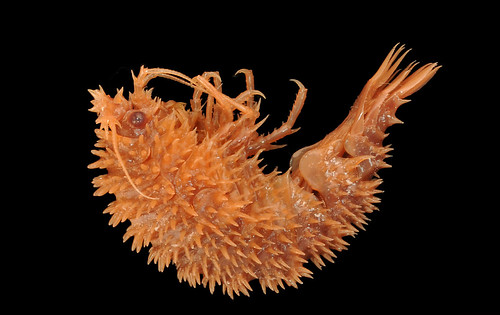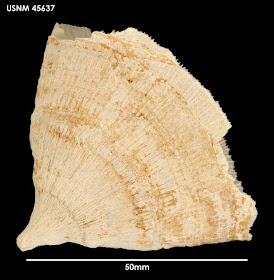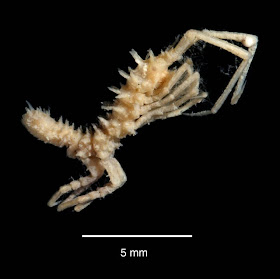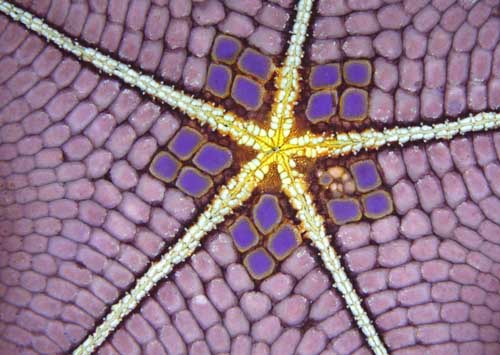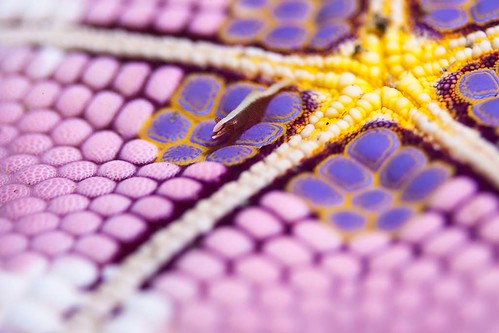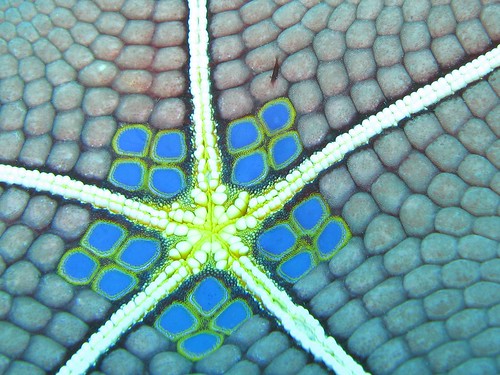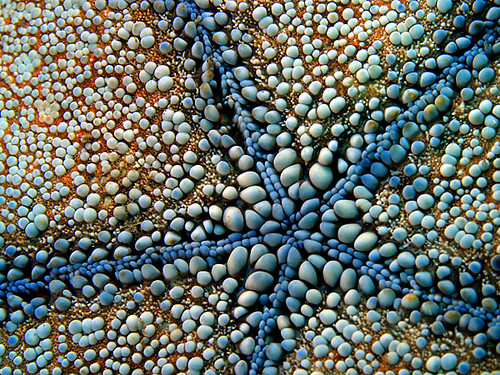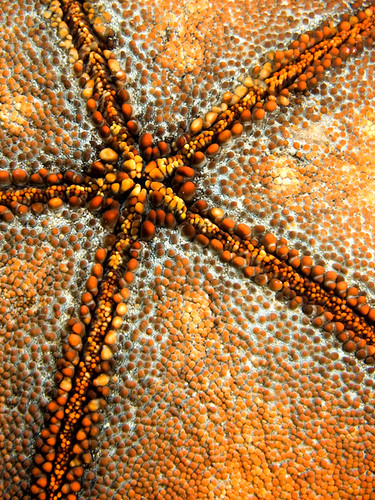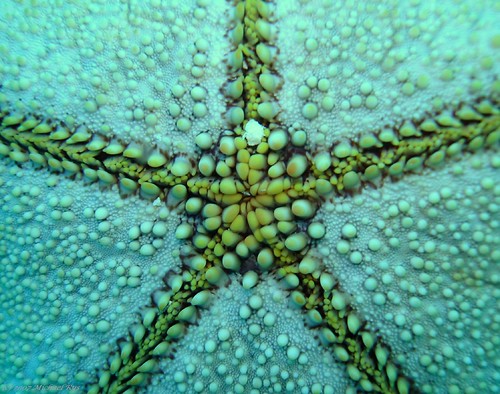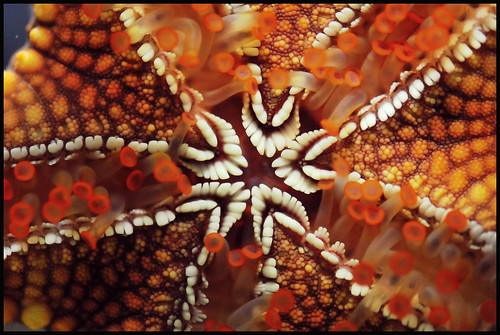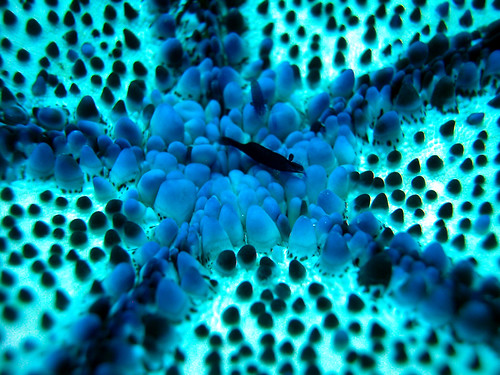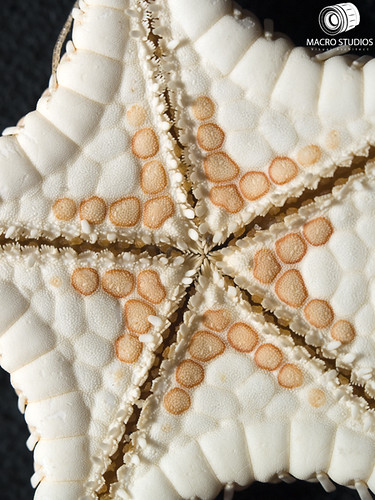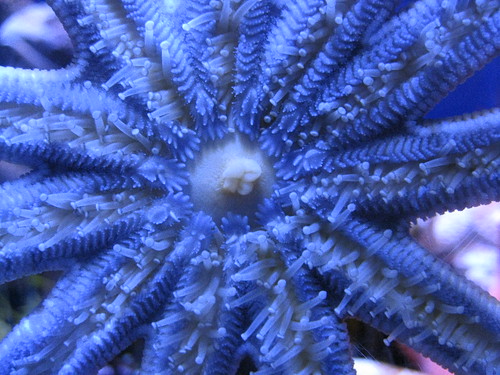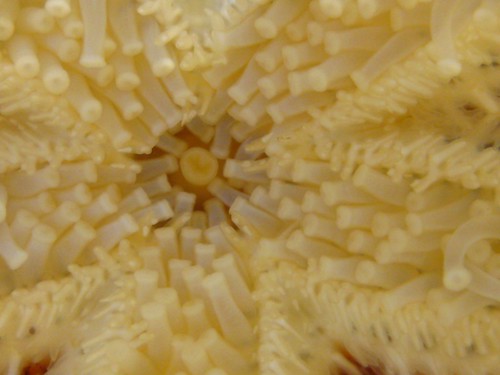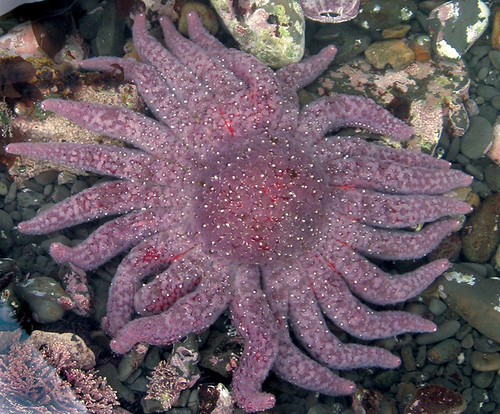I have talked about benthic ctenophores as an example of the kind of neat animal that divers see that scientists often do not-and how "citizen scientists" can play a role in documenting rarely encountered animals like these. (here). My friends over at Blennywatcher.com have some INCREDIBLE video of benthic ctenophores living on the sea star Echinaster luzonicus from Lembeh! Check it out!
Echinodermata! Starfish! Sea Urchins! Sea Cucumbers! Stone Lillies! Feather Stars! Blastozoans! Sea Daisies! Marine invertebrates found throughout the world's oceans with a rich and ancient fossil legacy. Their biology and evolution includes a wide range of crazy and wonderful things. Let me share those things with YOU!
Pages
▼
Wednesday, May 30, 2012
Tuesday, May 29, 2012
ANAL CONES! Diadematid sea urchin mysteries!
Echinothrix from Lembeh Strait Photo (above) by Efdixon
Another day when pictures say more than words! What is an anal cone???
The anal cone is the weird, prominent bulb-shaped bit (its white in the species below) that is sitting on the top of the test (i.e., the body) in sea urchins of the family Diadematidae, which are well-known for their big long sharp spines....
But what function does it serve??
The Anal cone seemingly falls into the "poorly understood" category but I did find some explanations..
Ailsa Clark from Echinoderms of the Seychelles (pg. 84)
Another peculiarity of this family is that there is an elongated anal cone or sac which is commonly inflated like a small balloon in the centre of the upper side. This may gently roll around its attachment and is believed to have a respiratory function".
Hendler et al. (1995) in the book Sea Stars, Sea Urchins, and Allies, Echinoderms of Florida and the Caribbean note in the tropical Atlantic Astropyga magnifica
As in Diadema antillarum, the anal cone enables the animal to eject feces away from the body.So here's a diversity of anal cones from various diadematid urchins! If they are for ejecting feces then these are some of the most aesthetically pleasing feces ejecting structures that I've seen among animals!
I believe this is Echinothrix from Hawaii
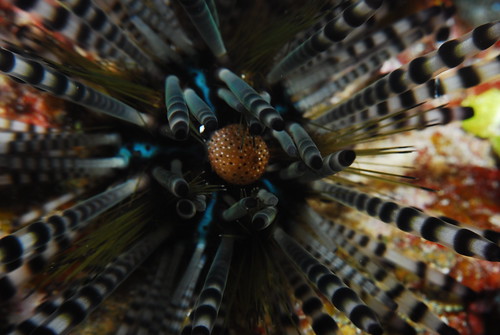
Photo above by JLambus
Astropyga from Sulawasi (photo below by pauldub)

Astropyga from Indonesia
Photo above by PacificKlaus
Another by PacificKlaus. Looks to be Echinothrix? from Okinawa, Japan
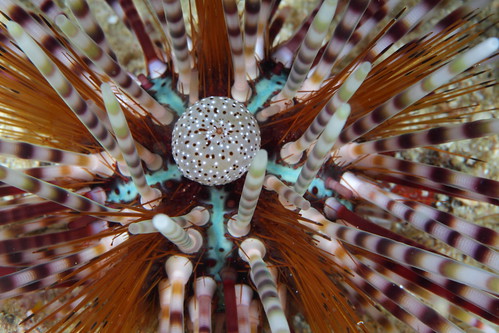
Astropyga from Lembeh, Indonesia
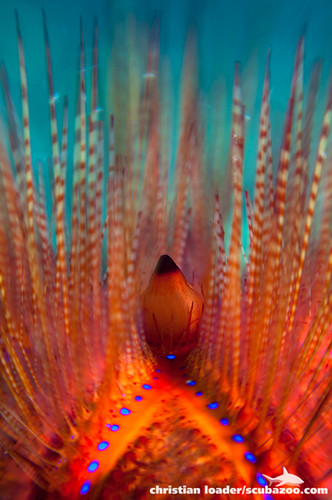 |
Another by Christian Loader. Maybe Echinothrix from Lembeh,
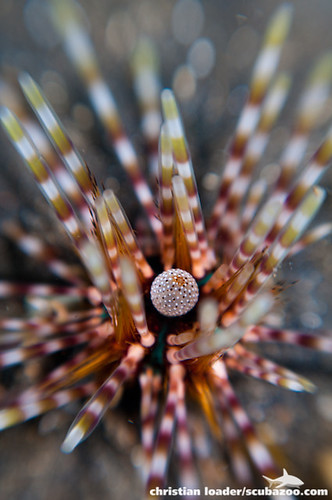 |
Diadema? from tropical Atlantic
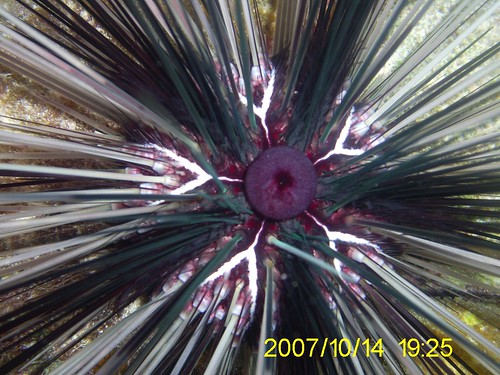
Photo above by marcsdad50
Echinothrix from Sulawasi (photo below by fisheyedave aka David Cropp)
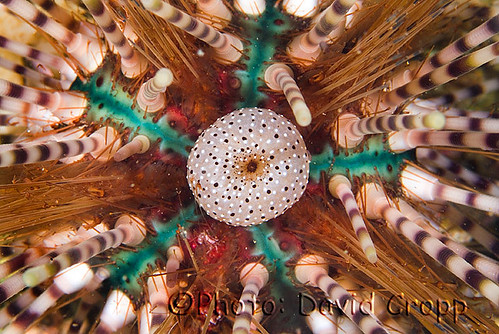 |
Here's one from Diadema (the Philippines). Photo below by maxette
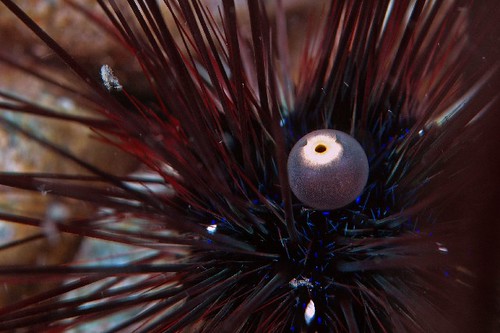 |
Tuesday, May 22, 2012
10 of the WEIRDEST Antarctic Invertebrates!!
Last week the foks over at NewsWatch National Geographic proclaimed that they had the "5 Weirdest Antarctic species".
Hyperbole is all good and fine, but there was true nerd-rage that "they" (note-species identified as "weirdest" by Huw Griffiths as per their aritcle-but still unqualified in the title) could presume to not only make a claim of "weirdest" ANYTHING but not to include an echinoderm??? -the WEIRDEST of all the animals??? and not a starfish or worm to speak of!
And especially from Antarctica! Where echinoderms are part of the dominant fauna!!??? And to add insult to injury-to claim that among the "weirdest" was a fish??? Bah. I say. Double Bah!
Anyway-just to show you HOW weird Antarctica can get I decided to show you not just 5 but TEN of the weirdest echinoderms and other invertebrates that I know!
All invertebrates. No fish.
Go and learn. There will be horror, amazement and intrigue...
NON-Echinoderms!
1. Eulagisca gigantea- GIANT polynoid worm! 3 inch eversible proboscis! A member of the Polynoidae-a scale worm. Not much known about it. BIG! And can get up to about 9 inches to a foot long! Imagine meatloaf sized. Um. I'm guessing predatory.
(pictures below from the USNM US Antarctic Research Program)
Here's a video of this species (I think...) alive at about 0:41. Much more shaggy and loveable and not quite so toothy! (at least not that you can see)
2. Parborlasia corrugatus-Giant carnivorous/scavenger ribbon worms! Upwards of 3 feet long and in some cases-as thick as a garden hose and have the texture of jello. There's mucus. These things are crazy.
Key words: EAT EVERYTHING. ALIVE or DEAD. These have been fed almost everything-and they eat what's given them: fecal pellets, starfish, dead seal meat, fish, sponges, sea anemones, worms amphipods, penguin meat, sardine meat (with tomato sauce!) and on and on....
Plus they occur in abundance (especially around food)...
One of these days I should write these guys up on Echinoblog...
and remember this famous video? Those giant worms? THAT is Parborlasia!
3. Antarctic amphipods! Epimeria and others..There wasn't a lot known about the biology of these-but man, LOOK at em!! These are described species..KNOWN animals...
Epimeria macrodonta (fr. USNM USARP collection)
4. Flabellum-Stony coral that broods little baby coral! There's a neat paper by my colleagues Rhianne Waller, Paul Tyler and Craig Smith (here) which describes how these deep-sea Antarctic stony corals (related to the shallow kind everyone knows about) have LITTLE BABIES!!!
5. Weird Isopod Antarcturus hodgsoni So, you know those little sowbug/rollie pollies that you see in your garden??
Well, in Antarctica they get REALLY weird. There's spines and longer legs and and are actually kind of elongate. Bizarre.

There's something special about a place that gives you a world with neat beasts like the ones above.
They aren't as cute and fuzzy as seals or penguins-but when you think about the incredible evolutionary story of THESE animals (many of those stories-we are STILL learning!) compared to the warm and fuzzies realize that Antarctica is not just a place for "weird" but a place for wonderous and unique...
Hyperbole is all good and fine, but there was true nerd-rage that "they" (note-species identified as "weirdest" by Huw Griffiths as per their aritcle-but still unqualified in the title) could presume to not only make a claim of "weirdest" ANYTHING but not to include an echinoderm??? -the WEIRDEST of all the animals??? and not a starfish or worm to speak of!
And especially from Antarctica! Where echinoderms are part of the dominant fauna!!??? And to add insult to injury-to claim that among the "weirdest" was a fish??? Bah. I say. Double Bah!
Anyway-just to show you HOW weird Antarctica can get I decided to show you not just 5 but TEN of the weirdest echinoderms and other invertebrates that I know!
All invertebrates. No fish.
Go and learn. There will be horror, amazement and intrigue...
NON-Echinoderms!
1. Eulagisca gigantea- GIANT polynoid worm! 3 inch eversible proboscis! A member of the Polynoidae-a scale worm. Not much known about it. BIG! And can get up to about 9 inches to a foot long! Imagine meatloaf sized. Um. I'm guessing predatory.
(pictures below from the USNM US Antarctic Research Program)
Here's a video of this species (I think...) alive at about 0:41. Much more shaggy and loveable and not quite so toothy! (at least not that you can see)
2. Parborlasia corrugatus-Giant carnivorous/scavenger ribbon worms! Upwards of 3 feet long and in some cases-as thick as a garden hose and have the texture of jello. There's mucus. These things are crazy.
Key words: EAT EVERYTHING. ALIVE or DEAD. These have been fed almost everything-and they eat what's given them: fecal pellets, starfish, dead seal meat, fish, sponges, sea anemones, worms amphipods, penguin meat, sardine meat (with tomato sauce!) and on and on....
Plus they occur in abundance (especially around food)...
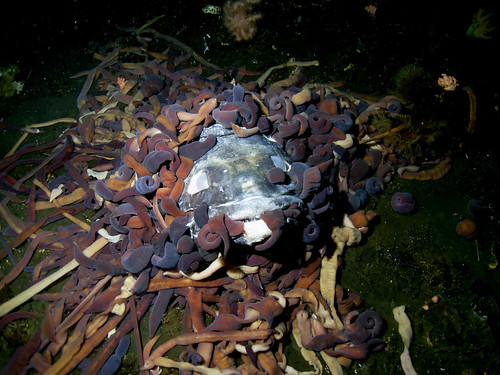 |
| Image by Scripps-Oceanography |
One of these days I should write these guys up on Echinoblog...
and remember this famous video? Those giant worms? THAT is Parborlasia!
3. Antarctic amphipods! Epimeria and others..There wasn't a lot known about the biology of these-but man, LOOK at em!! These are described species..KNOWN animals...
Epimeria macrodonta (fr. USNM USARP collection)
Aeginoides gaussi (fr. USNM USARP collection)
unidentified Acanthonootozomatidae
4. Flabellum-Stony coral that broods little baby coral! There's a neat paper by my colleagues Rhianne Waller, Paul Tyler and Craig Smith (here) which describes how these deep-sea Antarctic stony corals (related to the shallow kind everyone knows about) have LITTLE BABIES!!!
These little guys below are orange/red and they literally just crawl in and about the cup above! They're only a few mm long. Cute! But whodda thunk that coral had little babies??? (Fig. below from Waller et al's paper) These eventually crawl away and build their own cups..but that is a story for another day.. (or you can just go read the paper.. )
5. Weird Isopod Antarcturus hodgsoni So, you know those little sowbug/rollie pollies that you see in your garden??
Well, in Antarctica they get REALLY weird. There's spines and longer legs and and are actually kind of elongate. Bizarre.
And FINALLY, the best for last! Echinoderms!
6. Labidiaster annulatus-50 rayed Predatory Starfish. A LARGE starfish (almost 2 feet across) with 50 rays that use claw-like structures called pedicellariae to catch MOVING prey (krill)!!! Click here to read more!

7. Cidaroid Sea Urchins. Strange antarctic Sea Urchins that have sponges, worm tubes and all sorts of other critters living on the spines. Not only do they flourish but the urchins carry/disperse these species into NEW areas and "seed" them with the animals on their spines.
GO read it..
GO read it..
8. Odinella nutrix. Brooding brisingid starfish! Odinella is not only a brisingid (as outlined here), that is, a sea star which feeds on moving prey using its arms and pedicellariae-but you see that big prickly spiny area around the disk?
Odinella BROODS juveniles! It keeps little baby Odinella in that big spiny briar patch it calls a disk!
9. Ophiuroids! Ophiosteira, Ophiomages and more! My colleague Rafael Martin-Ledo has written about Antarctic brittle stars in his blog-Antarctic Brittle stars!
Among the many interesting topics!
10. Finally...SEA PIGS!! Go here!(or click on the pic) There are actually several different genera and species of "sea pigs" (members of the family Elpidiidae) Not all of them live in the deep-sea, some of them live in Antarctic waters...
Some sea pigs live ONLY in Antarctic. Yes, some are found outside the Antarctic via the deep-sea but when you hear the next message about "saving Antarctica" realize that even if some of these species don't occur exclusively in Antarctica, they have close ties.
There's something special about a place that gives you a world with neat beasts like the ones above.
They aren't as cute and fuzzy as seals or penguins-but when you think about the incredible evolutionary story of THESE animals (many of those stories-we are STILL learning!) compared to the warm and fuzzies realize that Antarctica is not just a place for "weird" but a place for wonderous and unique...
Tuesday, May 15, 2012
Mouth to Mouth! A Close up look at the mouth armor of tropical sea stars!
Photo by Geoff Spiby (the cushion star Halityle)
Today I thought it would be cool to gather up close ups of various starfish and offer a perspective that most folks don't usually see.
Colorful and beautiful. Yes! But also, functional. A lot of the mouth you see below were photographs of sea stars from the tropical Pacific and Indian Oceans. The tropics are a tough place for some animals with many crabs and fish always willing to take a peck of tissue or a tube foot for dinner.
A great many of the sea stars in these areas come with protection- a LOT of it. Spines and armor adorn the soft, vulnerable areas of these sea stars. Those spines on the tube foot grooves you see below can actually interlace and close up the grooves to protect the vulnerable tube feet from being pecked at by fish, crustaceans or what-have you...
Here's another shot of Halityle from another angle. Plus you can see the tiny shrimp!
Photo by Shaun-in-Munich
From a "cushion star" probably Halityle.. (note the shrimp!)
Photo by Tanaka Juuyoh
This is from the more common "cushion star" (and why common names are so unhelpful) Cucltia novaeguineae
And another...
Both of the above photos by Nick Hobgood
Here's more Culcita goodness!
Photo by Michael Rys
From Fromia sp. Note how all of the spines interlace and protect the tube foot groove
Photo by Adam Broadbent
From an oreasterid (not sure which)-note how all of the large spines completely block the tube foot grooves and mouth
From an oreasterid(?) or something close to it. Note the very prominent white-colored spade-shaped oral plates that project into the mouth. The whitish furrow spines are thought to close over the tube feet groove under adverse conditions.
Another oreasterid that I'm unsure of the species-probably Pentaceraster. A nice perspective. Notice the tiny Periclemenes commensal shrimp!
Photo by Tahiticed
The colorful underside of what looks like the goniasterid Stellaster aequestris..
Here's a tropical goniasterid that lives in the deep-sea Atlantic-A weird animal called Gilbertaster that I worked on a few years ago.. See all of those elongate "lip" like things? Bivalve pedicellariae! See here for some more on pedicellariae.
Could these be for further defense?

In contrast-here's a cold-water starfish the sun star Solaster
Friday, May 11, 2012
Commensal Crabs RIDE that starfish!!!
Thanks to Anna and BlennyWatcher.com!
This is probably the first time that these swimming crabs have been observed living commensally on Luidia maculata (or possibly on ANY starfish).
When people talk about commensals (crabs or whatever) living on a larger host, its often assumed they are taking advantage of things like food (from what the sea star eats) and protection..but here's ANOTHER potential "win" for the crab-TRANSPORT (aka dispersal). Is this possibly how these crabs get around from one place to another??
Note also how the animal keeps on arching up? It doesn't seem to be expelling gametes (as has been documented here before) so maybe its not all too fond of the crab attention and trying to shake them off??
Ride the Luidia Express!
Wow! Have a great weekend!
This is probably the first time that these swimming crabs have been observed living commensally on Luidia maculata (or possibly on ANY starfish).
When people talk about commensals (crabs or whatever) living on a larger host, its often assumed they are taking advantage of things like food (from what the sea star eats) and protection..but here's ANOTHER potential "win" for the crab-TRANSPORT (aka dispersal). Is this possibly how these crabs get around from one place to another??
Note also how the animal keeps on arching up? It doesn't seem to be expelling gametes (as has been documented here before) so maybe its not all too fond of the crab attention and trying to shake them off??
Ride the Luidia Express!
Wow! Have a great weekend!
Tuesday, May 8, 2012
Starfish Bouts!! Behavior REVEALED!!!
Photo by Dida K on Flickr!
"Do Starfish EVER move? "Are those sea stars alive?"
These are ACTUAL questions I have been asked by the public.
Probably the most characteristic aspect of starfish biology is defined by something that most of us don't regularly see. Movement.
Its important to realize how important understanding movement can be. We often identify "living things" by recognizing if they move. We perceive behavior from how they move.
Starfish are animals. And they DO MOVE. BUT they do so at a much slower rate and we humans generally require video assistance in order to recognize that they do.
Its kind of like that old Star Trek: TOS series episode "Wink of an Eye" where the crew runs into aliens that are hyperaccelerated because of the water present in the alien planet.
Here, Spock samples the water becoming hyper-accelerated and watches McCoy and Nurse Chapel slow down. McCoy and Chapel are the "slow" starfish. They talk and interact normally among themselves but are slow compared to hyperaccelerated Spock!
A key paper from 1975 by a young marine biologist at San Francisco State named Don Wobber was the first to observe sea stars using cameras and SCUBA diving. His paper was published in the Biological Bulletin and is available here for free!
His materials and methods reveal a story...
Field observations resulting from about 240 hours of scuba diving between 1971 to 1974 were done in a 75 X 40 m study area....Undersea observations were recorded on plastic writing boards and by still or motion pictures, the latter augmented with time lapse series analyzed frame-by-frame.That is a LOT of time watching starfish! He complimented field observations with lab studies with various California starfish motivated by food and the presence of other starfish species..
Wobber identified that starfish ARE behaviorally complex.
They display a wide range of discrete movements which one observes between any number of different individuals. Sometimes between members of the same species and sometimes between members of different species.
His figure two (below) briefly displays different types of interaction
- Bouts between bat stars (Patiria miniata) were often related to food gathering. Bouts could last anywhere between 3 to 120 minutes.
- Bouts were commonly observed among individuals studied
- Sea stars demonstrated "win" in bouts where they were familiar with the home area versus bouts where individuals were unfamiliar with the area. This implied that these animals might show "home advantage" in interactions against non-familiar individuals.
- Extracting-withdrawing a ray from beneath the opponent without a general withdrawl of the whole animal
- Lifting-raising the ray to a position above the top surface of the opponent.
- Holding-holding the ray in a position over the top surface of the opponent.
- Feinting-Slight lowering and raising of the ray when in the holding position.
- Arching-holding of the ray further back than in the holding position in a position above the sea star's own top surface often with the ray in an 'S' position
- Dropping-lowering the ray toward the opposing sea star
- Reaching-stretching the ray out onto the top surface of an opposing sea star after a dropping motion
- Pushing-forcing of the arm tip of a ray against the distal end of the ray of the opponent, often folding the tip of the ray over the opponent's ray.
- Locking-surrounding and pressing in of two rays of one animal onto another animal. (two or more bat stars in locking positions will often share the same food item).
(thumb wrestling image from Wikipedia!)
Here is a great pic of two bat stars engaged in a bout (although I'm not sure which of the actions above they are performing) (p.s. to Dida K- THANK YOU!!)
and another..

Photo by Dida K on Flickr!
Note the arms raised in bout position here also...
Photo by CatSnorkelScuba!
Some behavior was isolated to individual species. For example, the giant sunflower star, Pycnopodia helianthoides
Photo by "yawnthensnore"
had a unique move when one individual came in contact with another. To quote Wobber (pg. 487)
A ray movement position unique to Pycnopodia is side-slipping, the semi-horizontal sliding of rays between, then over and onto the rays of the opponent, sometimes accomplished by a rotating of the whole body clockwise or counter-clockwise. Pycnopodia did not engage in feinting, pushing or locking positions.Different 'bouts' could result in different outcomes including "wins" (advantage), "losses" (disadvantage) and the "ties" (neutral).
Different factors could affect each the advantage or "win" of each interaction, including greater size of an individual, position of the madreporite and so on.
A summary diagram of the many complicated interactions is shown below (from Wobber's Figure 7).
Thick lines indicated how frequently a particular behavior occurred. Arrows indicate direction of a sequence of actions.
When large food sources were placed out in the water in order to see how many different bat stars would converge on a large food source, Wobber discovered that individuals that were the first to arrive would fend off the other subsequent approaching individuals. Many bouts ensued as the bat stars would clash over the food.
Wobber re-visited this event in the 90s (along with John Pearse from UCSC) in this awesome video from the "Shape of Life".
They compare the behavior of bat stars to that of the most aggressive of African predators. A primary "alpha dog" starfish stakes his/her claim on the food and proceeds to "bout" with all the challengers.
And there's MORE! If you look closely at the many, many Antarctic Odontaster penicillatus in this classic BBC time-lapse video you can observe the "bouts" between different individuals interacting among one another.
So..this week's take home messages!
Starfish can MOVE and are behaviorally COMPLEX!!! Conceivably as much as ANY vertebrate (maybe even more?)
Who knows? All the while we've been ignoring them, who knows what kind of shennanigans they've been up to....
